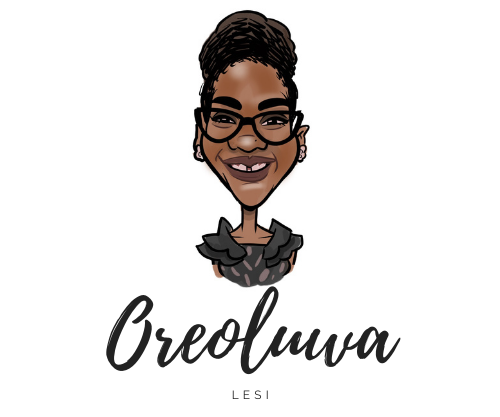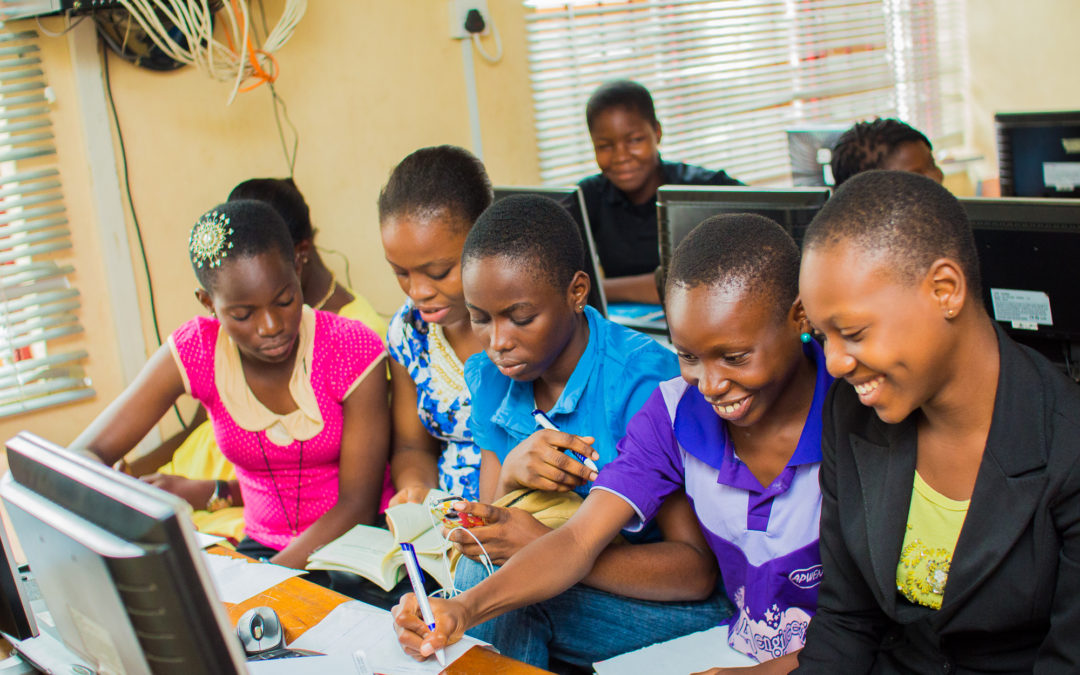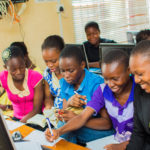Introduction:
The themes of this year’s International Women’s Day were “Balance for better” and “Think equal, build smart, innovate for change”. Both are fitting when we examine the issue of gender equality in Science, Technology and Engineering, because there are fewer fields that demonstrate the legacy of historical under-representation as well as the STEM fields. Nowhere is this more apt than in technology.
STATS:
In Nigeria, according to the National Bureau of Statistics, women make up on average just 22% of the total number of Engineering and Technology university graduates each year.
According to the same source, women make-up roughly a fifth of the total number of people working in information and communication technology sector.
Globally, the available data shows that only 35% of girls enter further education in STEM subjects and many have little encouragement to equip themselves with the skills to thrive in these industries.
WOMEN IN THE HISTORY OF COMPUTING:
It is interesting that this is the situation we find ourselves in today, because because women played an important role from the early years of computing.
Without the work of tech pioneers like Hedy Lamarr and Barbara Liskov (in the U.S), we would not have Wi-Fi and email.
Ada Lovelace was regarded for many years as little more than Charles Babbage’s personal assistant.
He showed her plans he had for a machine that could do complex math calculations and asked her to write an article about his work for a journal. In her article, Ada Lovelace envisioned that this machine could actually do much more than just calculations, as long as the command or instructions could be expressed in a logical way. In her article, she gave an example of an instruction with Bernoulli numbers, which could be fed into a machine. And by so doing, she became the world’s first computer programmer.
Roughly a 100 years later, the world’s first modern computer was being built. The ENIAC (Electronic Numerical Integrator And Computer in 1946) was the world’s first electronic general-purpose computer.
Back then, “men were interested in building, the hardware, doing the circuits, and figuring out the machinery”. So, building hardware was a male-dominated job and considered to be very important work.
In the 1930s in the US, maths was a common degree for women to study, although many of them ended up working as maths teachers. However this analytic training meant that women made very good programmers.
But since the hardware was regarded as the star and software less important, it meant that the job of programming was extremely lacking in prestige. In fact, the women were not referred to as programmers, but as operators.
The women who programmed the ENIAC were never recognised for their efforts until many years later (Source: https://www.npr.org/sections/alltechconsidered/2014/10/06/345799830/the-forgotten-female-programmers-who-created-modern-tech).
In the 1980s, the numbers of women studying maths and computer science in the U.S. began to drop from about 40% to 25% (National Girls Collective Project, and NSF Indicators 2016); while the popularity of computer science as a course of study among men began to rise. Incidentally, this was also about the time that witnessed the rise of the personal computer with Microsoft co-founder Bill Gates and Apple co-founder Steve Jobs were gaining worldwide prominence.
Some have deduced that the availability of positive male role models and the invisibility of women in the field played more than a little part in the rise and fall of interest in computer science and technology among boys and girls respectively.
Whatever theory you believe, the fact is that today, women and girls are still underrepresented in science, technology, engineering and maths (STEM) education and careers.
USING ALL THE PLAYERS IN THE TEAM
Research has shown that diverse teams of developers – that is teams that look like the rest of society – create the best tools.
Society is roughly 50% women and 50% men. So why shouldn’t this apply to the people who create the technology that we all use?
MARIAM
Imagine, you are a little girl; or perhaps think of a girl you know.
Let’s call her Mariam. Mariam is a 7 year old girl. She’s bright and spirited. She has two brothers and they play together a lot.
Her brothers have toy cars, lorries, science kits, robots, construction sets and video games. She has dolls, doll houses, kitchen sets, a kit to make clothes for her dolls.
Her brothers refuse to play with any of Mariam’s toys, so they always end-up playing with their toys. But Mariam doesn’t mind. In fact she enjoys it. She can build higher towers than her brothers. She can make crystals from the science kit. She gets really high scores on the video games. The robots she builds can do all sorts of complex things, which her brothers’ robots can’t do.
She thinks that when she’s older, she might like a job where she gets to build cool things.
But everyone tells Mariam that these are boys’ toys and she should be more ladylike and play with ladylike toys.
In class, her teachers generally call on the boys more. In the films and TV shows she watches, most of the scientists and technology experts are male.
She is told that a career in technology will take too many years and she will be too old to get married by the time she graduates.
She’s not sure when it happens, but eventually she stops playing with her brothers altogether.
Fast forward a few years. Now Mariam is fourteen. She does well in her science, maths and computer classes but by now she no longer thinks about becoming an engineer or computer scientist or anything remotely technology-related.
Mariam might have produced innovation that could solve some of our biggest problems in healthcare, education, the environment, agriculture, or finance.
But Mariam doesn’t believe anymore that there is a place for herself in science and technology. So we will never know what Mariam and all the other girls like her could have achieved.
We have seen from the case of Mariam that society’s messaging about who belongs in technology has a lot to do with why many girls don’t even consider careers in technology.
The research certainly seems to back this up and shows that up to the age of 11 or 12, girls indicate they like maths and science and do as well in it as boys of their age.
After this age, is probably when girls become more sensitive to the implicit messages that society sends about who belongs in technology. They see images of an engineer or programmer on TV or in books and that person is in most cases a man.
Of the women who do start off in a career in technology, research has also shown that many drop out within the first 10 years.
This means that relatively few women are making it to the top positions in computing and technology.
So for a girl like Mariam who is thinking about what she would like to do when she gets older, she looks at the technology space. She doesn’t see anyone who looks like her and the overwhelming message is that this is not a field for her.
——————————
W.TEC & OUR RESULTS
I started my work of attracting more girls to technology – with the Women’s Technology Empowerment Centre, W.TEC – a decade ago.
We have since organised early-stage intervention programmes such as technology camps, afterschool clubs, hackathons for girls aged 11 to 17 years. And through our programmes, reached 27,000+ girls and women.
——————————
5 KEY STRATEGIES
We have observed a few strategies that work in attracting more girls to computing and technology:
1. Start early: Technology classes and workshops can be a good way to technology more accessible.
But make them fun and engaging. Teach girls to create and build (robots, apps, websites, a short film).
Show them that they can technology developers and not just consumers.
Find out what they are interested in or concerned about and have them create a tool that addresses this.
So, a team of girls we worked with developed an app that gave fashion advice on the type of clothes that suited different body types.
Another group developed an app to report rape and other incidences of sexual violence.
2. Preferably make these programmes for girls-only. Yes, we know the real world is not made up on one sex alone, but research has shown the value in creating female-only spaces or programmes, where girls feel safe enough to ask all their questions and make mistakes without worrying too much what others think of them.
And for many girls, this is easier to do when they don’t have to worry about how to deal with the boys in the room.
3. Provide access to positive female technical role models and mentors, who give realistic pictures of what their jobs are like.
A girl like Mariam perhaps would have seriously considered a technology career if she knew women working in technology, thereby giving her something to aspire to.
4. Develop a community of intelligent, ambitious women in technology who can support each other with advice, learning resources. This is CRUCIAL. In order to have more women working in and excelling in technology, it’s not enough to make girls want to study technology.
We also need to help sustain their interest as they start and progress in their careers.
Women in technology often find themselves the only woman in their class, team or department.
Having women (and supportive men) who have gone ahead and can offer guidance on how to build a successful career is invaluable.
5. Connect her with work experience, where she can build-up her technology skills and really make the connection between what she’s learning and its application to the workplace and solving real-life problems.
——————————
OUR ALUMNAE
Our results have been interesting. Close to 86.21% of our alum have committed to or expressed a strong interest in pursuing a STEM career.
One such graduate is Sophiyat. She attended our technology camp for girls 4 years ago when she was 13. When I met her, she expressed a passing interest in technology. Fast forward a few years and she was teaching other girls to create mobile applications and build video games. Today, she is studying Computer Science at Lagos State University.
Another is Dolapo. She also attended the girls technology camp in 2012 when she was 12. Afterwards, she participated in hackthons and competitions, which we organised and one of which was supported by Oracle. She also taught at other editions of the camp. Now Dolapo is studying Applied Sciences with a minor in Computer Science in the United States.
They have all started a path that I hope will take them to fulfilling careers in technology. However, the journey ahead of them is still a long one.
—————————————-
CALL TO ACTION
Closing the gender gap in technology starts with lighting a small spark of interest in girls, but also assuring them that there is a place for them in computing and technology. It continues with ongoing support for as long as necessary.
Parents, please don’t shower your daughters with gifts of dolls and kitchen sets, while letting your sons have all the cool building and robotics kits. Otherwise, you are telling your daughter that her future options don’t go beyond being caring and cooking for others.
Instead, you can give her both the dolls AND the robots.
If you are a woman in tech, please share your stories because girls need to know that it’s possible to be a women building a successful career in technology.
We need to continue to – in the words of this year’s IWD theme, make concerted efforts to balance for better.
Tell girls about successful Nigerian women in technology such as:
-
Dr. Omobola Johnson (Nigeria’s 1st Minister of Communications Technology),
-
Florence Seriki, of blessed memory (MD of Omatek Computers, the first Nigerian computer manufacturing company)
-
Funke Opeke (CEO of MainOne Cable),
-
Prof. Adenike Osofisan (the first Nigerian woman to get a PhD in Computer Science),
-
Juliet Ehimuan, Google’s Country Manager,
-
Ommo Clark (Founder iBez, Nigerian software development company)
-
Nkemdilim Begho, founder, Futuresoft.,
-
Moyinoluwa Adeyemi, Android app developer,
-
Abake Adenle (founder of Ajala app),
-
Damilola Ade (founder of CodeIT).
-
And all the women working tirelessly in technology
AND FOR THE FUTURE..
It is my hope that every girl who likes to use technology and is interested in maths and sciences never loses that love and joins the next generation of women creating amazing tools that are solving the world’s biggest problems.



Recent Comments